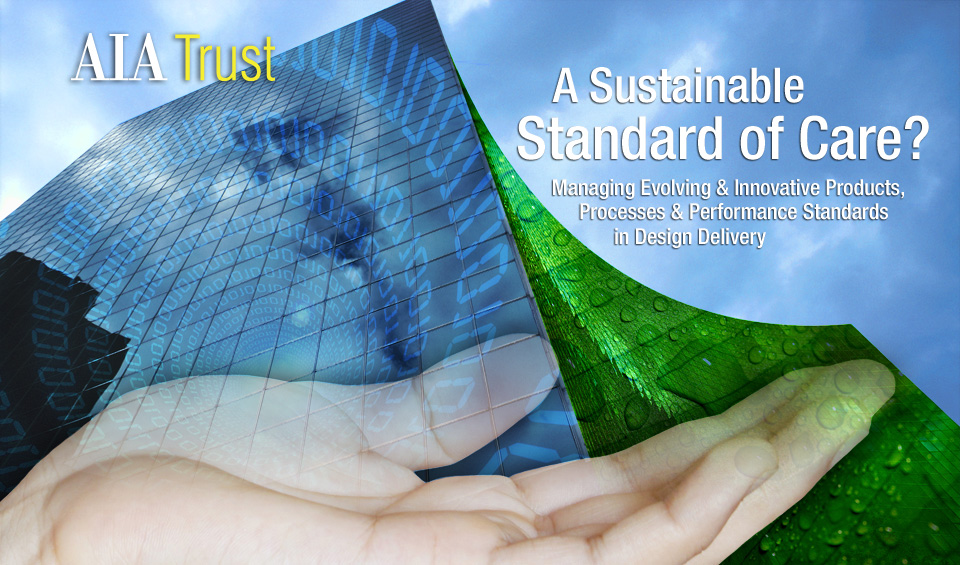We live in an age of ever-accelerating change and “advancement”. On the one hand, technological advancement provides the lure and expectation of increased opportunities and efficiencies. However, those new technologies, products, and approaches present an increased potential for failure and disappointment. Design professionals are constantly expected to find new ways of building projects better, faster, cheaper and greener, while at the same time they are viewed as professionally and financially responsible if those new methodologies and materials do not meet goals or expectations.
These challenges are currently manifested with expanding options in products and technology along with a lack of a proven history of performance of these new options. This AIA Trust white paper, A Sustainable Standard of Care, seeks to analyze and provide a framework to analyze these questions, and provide practice management tools to manage proactively the communications, performance, and related risks.
In a world of rapidly-changing design options, project objectives, and design tools, the standard of care for architects is best promoted, elevated, and defended by focused and strategic process management. This means the process of information and communication management matters as much as does the technical design itself.
A process-based model seeks and is built on a common and confirmed set of client expectations and objectives. This model recognizes that claims arise almost equally from technical design errors and non-technical practice management issues. When strategically applied, process management reduces both technical errors and non-technical failures.
The development of project and practice specific procedures and tools can and should be based on the application of four fundamental and sequential building blocks. They include the development procedures centered on core project types, contracts that best define the standard of care, and achievable goals and objectives that are adaptable to meet project demands. With effective process management, architects will prioritize and commit themselves to consistent and effective documentation.
Communication, contracts, and documentation are the keys to this process. A proper checklist for an effective informed consent includes: a project description; proposed or recommended action or approach; goals, purposes, and benefits of the approach; risks and consequences; feasible alternatives with either a comparative evaluation or a statement that such comparison will be provided if requested. Accordingly, documentation becomes the key.
Should design professionals not use new products or apply existing products in new ways? Absolutely not. Where the product or application is neither “ordinary” nor “similar”, the standard of care must become more about expectations, communications, and diligent process than technical outcomes.
One of the most frequent sources of failed client relationships and litigation is unrealistic, inappropriate, or uncommunicated client expectations. The only way to control this risk is to educate and shape client expectations. Architects and clients must acknowledge that the use of products or applications is not the standard or traditional approach and document this acknowledgement to the extent possible.
The single and most critical strategic decision with respect to a new product, technology, or application is to determine what level of investigation into and analysis of the product or application the design professional will undertake. As with any discussions and decisions which precede the actual contract, they are meaningless if not incorporated into the contract itself.
The final step is to deliver a project consistent with the strategic approach selected by the design professional. As new tools and processes for design delivery are presented, design professionals face an inherent trade-off between opportunity and risk. The opportunity to provide services better and less expensively is obvious. The risks are less obvious.
The latest and greatest trends or demands with respect to the design process and innovative technology are unquestionably BIM and the related, but even more varied concept of “IPD”.
The demand for sustainable, green design projects is unmistakable. The AIA has now made “environmentally responsible design” a primary consideration and focal point for all of its members and, by extension, the design community as a whole. As a result, it is now difficult to imagine any architect who would not be compelled to at least explore the sustainable requirements for a project on both the client interest level and the governmental requirement level. It is easy to argue that this now is the new minimum standard of care.
The great challenge is exactly what professional obligation follows the exploratory discussion. Architects should appropriately limit their obligations to a standard based on reasonable expectations of product performance and project maintenance and operation, with an appropriate disclaimer of any performance guarantee. The lack of any reasonable or recognizable boundary for the opportunities and obligations of a “green” project is the single greatest obstacle to the defense of a design claim based on “sustainability” issues.
For this reason, architects will be best served by avoiding the broad use of the generic terms “green”, “sustainable”, “environmentally responsible”, and “sustainable development” in their own Agreements, documentation, and work product. Instead, wherever possible, the sustainability references and discussions should be reduced to more definitive concepts and clearly expressed goals, expectations, and commitments.
Finally, even though there are now nearly 50,000 LEED-accredited professionals in the United States, LEED accreditation does not necessarily equate to a professional capacity to create a sustainable, environmentally sensitive project for all purposes. As stated above, the threshold issue for any architect standard of care focuses on education, training and skill.
The new opportunities and evolving products, processes, and performance standards are unlikely to slow down and will only continue to challenge architects in more intense and rapid ways in the future. Under those circumstances, the traditional external standard of care based on how others have performed falls away in favor of standards for communications regarding expectations, realities, reliance, and investigation, along with a process of implementation. This will become the defining standard for the “ordinary, but reputable” architect. The hope is that the principles discussed above will provide the basis of a strategy to keep pace with these changes for the mutual benefit of architects, their colleagues, clients, and insurers.
